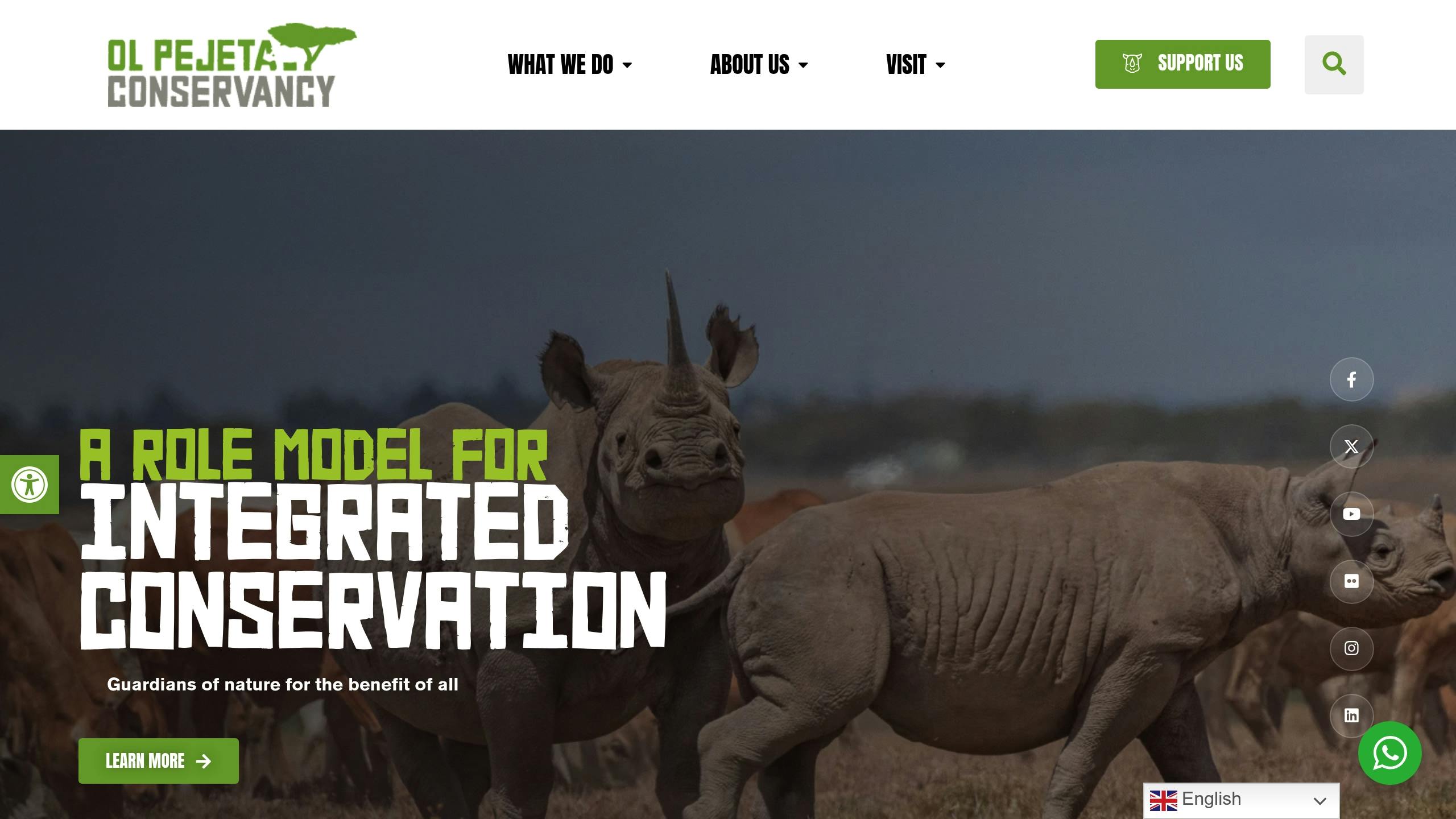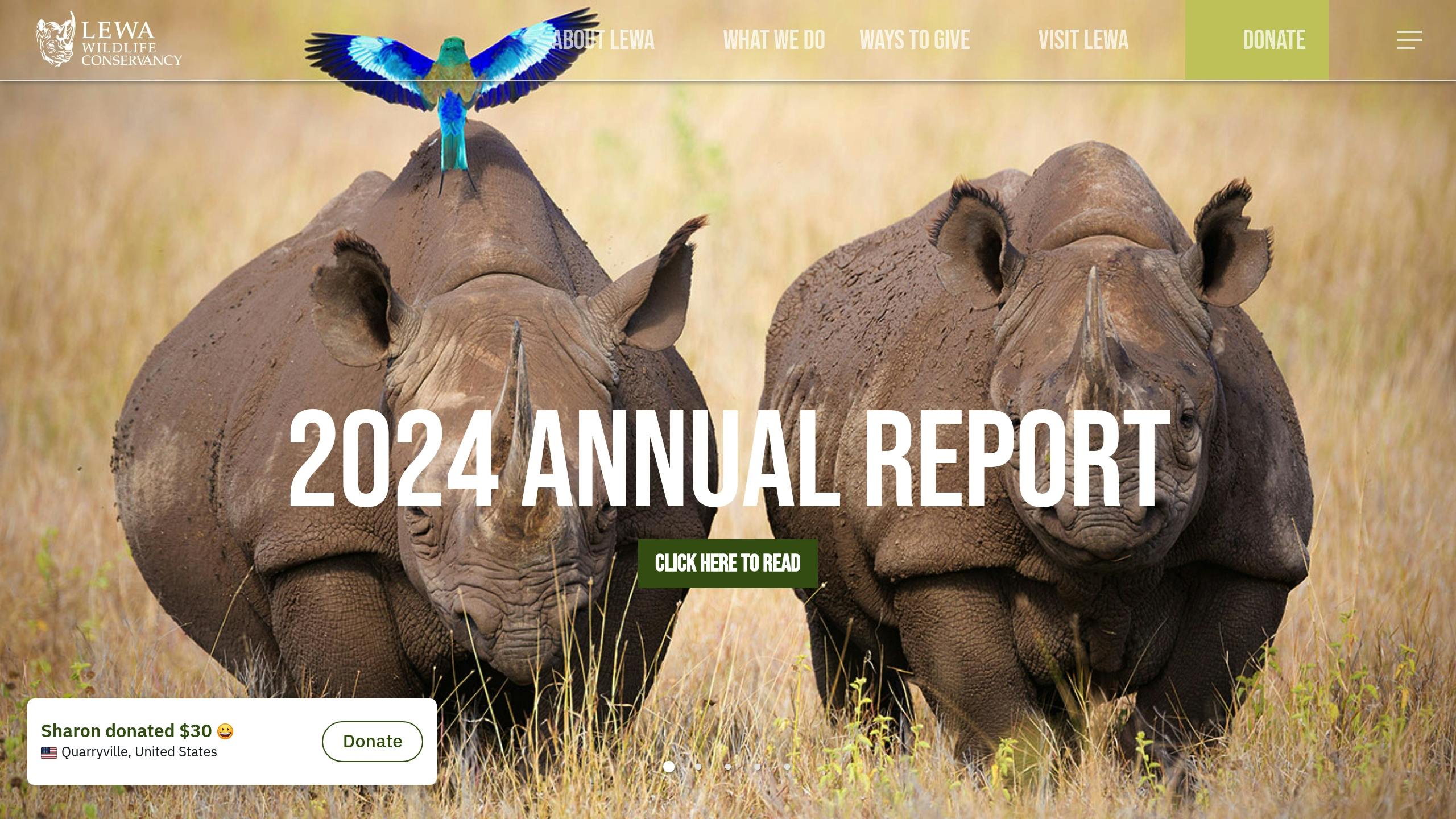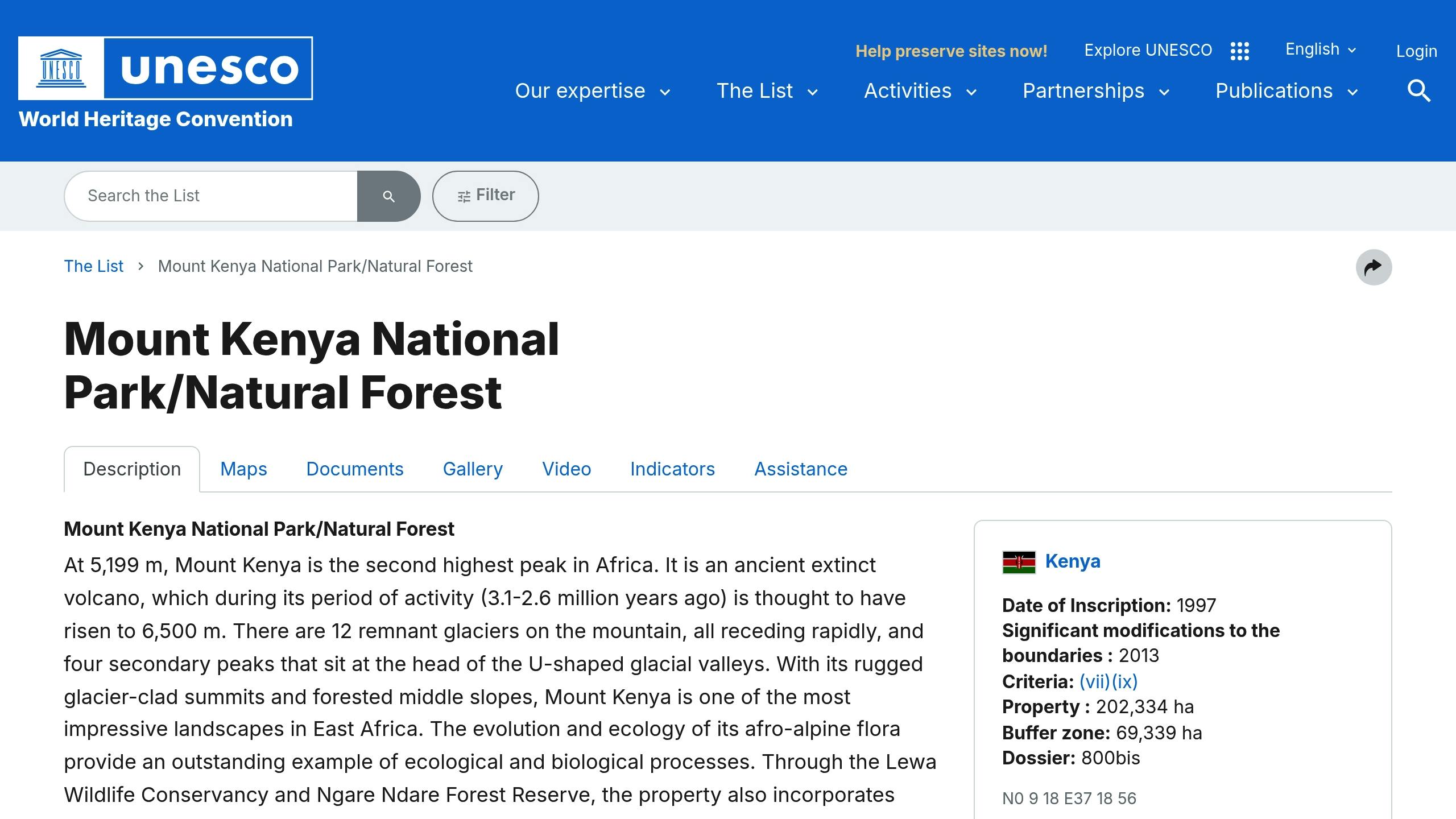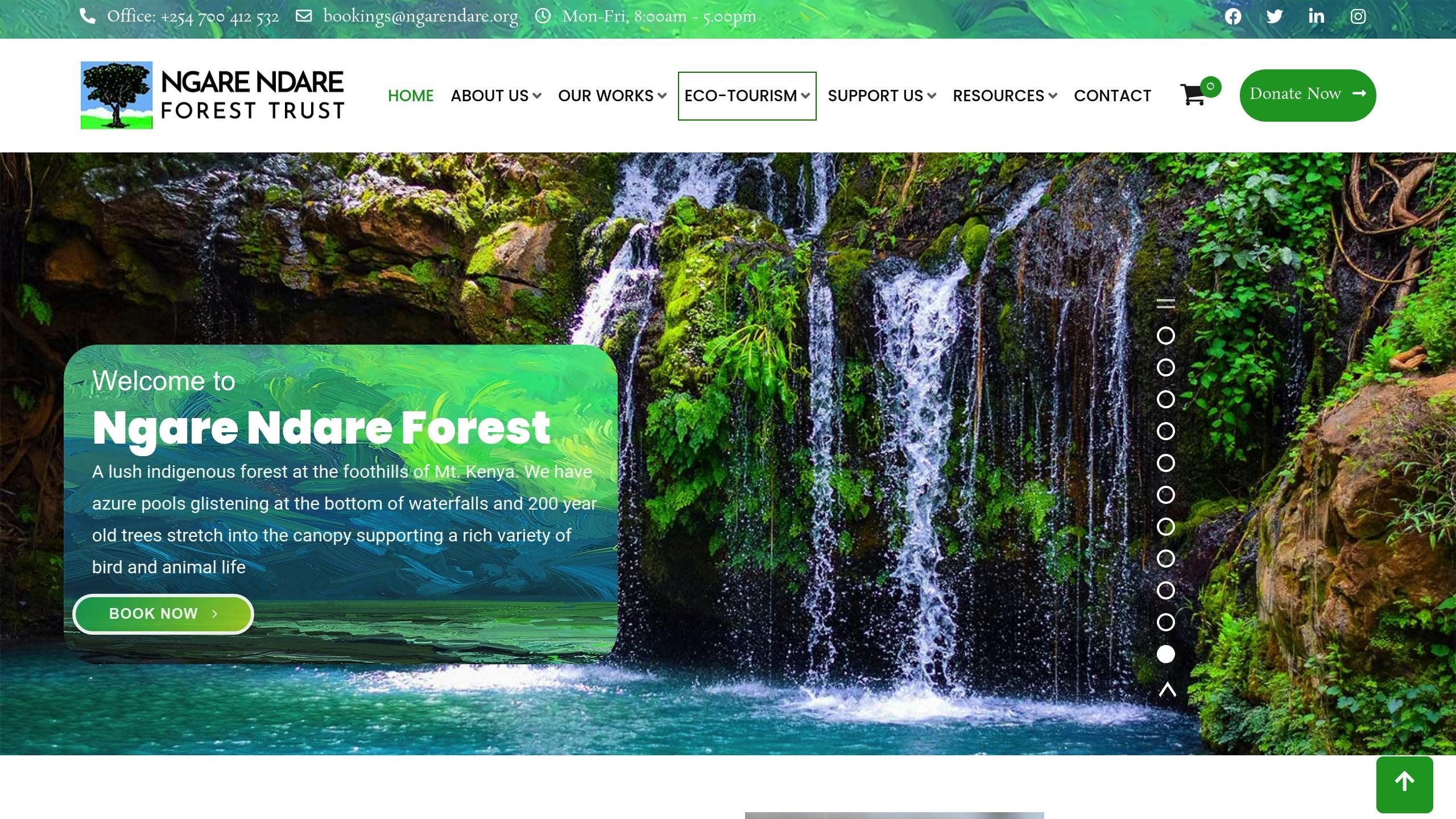Looking for the best wildlife experiences near Mount Kenya? Here’s your quick guide to the top 8 destinations:
- Aberdare National Park: Lush mountain forests with elephants, rare bongos, and nocturnal wildlife at floodlit waterholes.
- Ol Pejeta Conservancy: Largest black rhino sanctuary in East Africa, plus the last two northern white rhinos.
- Meru National Park: Untouched wilderness with Big Five animals and a growing rhino sanctuary.
- Samburu National Reserve: Unique dry landscape featuring the “Special Five” like Grevy’s zebra and Somali ostrich.
- Solio Ranch: Pioneering rhino sanctuary with over 200 rhinos and consistent wildlife viewing.
- Lewa Wildlife Conservancy: Home to 14% of Kenya’s rhinos and 90% of the world’s Grevy’s zebras.
- Mount Kenya National Park: UNESCO site with diverse wildlife like elephants, leopards, and over 130 bird species.
- Ngare Ndare Forest Reserve: Elephant migration corridor with a canopy walkway, waterfalls, and natural pools.
Quick Comparison
| Destination | Key Features | Best Time to Visit |
|---|---|---|
| Aberdare National Park | Forests, rare bongos, nocturnal wildlife | June–Sept, Dec–Feb |
| Ol Pejeta Conservancy | Black rhinos, chimpanzees, Big Five | All year |
| Meru National Park | Big Five, rhino sanctuary, fewer crowds | June–Oct |
| Samburu National Reserve | Arid landscape, “Special Five” species | June–Oct, Dec–March |
| Solio Ranch | Rhino conservation, compact wildlife viewing | June–Sept, Dec–Feb |
| Lewa Wildlife Conservancy | Rhinos, Grevy’s zebras, elephant corridor | July–Sept, Dec–Feb |
| Mount Kenya National Park | Mountain wildlife, UNESCO site | June–Oct, Jan–Feb |
| Ngare Ndare Forest Reserve | Canopy walkway, waterfalls, elephant migration | June–Oct, Dec–March |
Plan your visit to align with the best seasons and activities for each location. Whether it’s spotting rhinos, trekking Mount Kenya, or walking through forest canopies, these spots offer something for every wildlife enthusiast.
Mount Kenya Wildlife Conservancy Experience
1. Aberdare National Park

Situated just a few hours from Mount Kenya, Aberdare National Park offers incredible wildlife experiences within a lush mountain forest. Located about 160 km northeast of Nairobi, the park is home to four of Africa’s Big Five – though lions are notably absent.
The park’s eastern forested area, called the “salient area”, is a prime spot for observing elephants and Cape buffaloes. It’s also one of the rare places to see the endangered mountain bongo antelope, which is part of a breeding program shared with Mount Kenya National Park. These features make it a standout destination for wildlife enthusiasts.
For a unique experience, stay at Treetops Lodge or other tree hotels. These accommodations provide nighttime viewing opportunities at floodlit waterholes, where you might see black rhinos, giant forest hogs, large-spotted genets, and other nocturnal animals – all from the safety of elevated platforms.
During peak seasons (June–September and December–February), animals flock to the waterholes, increasing your chances of spotting wildlife. Visitors frequently see forest primates like black-and-white colobus monkeys and blue monkeys, as well as defassa waterbucks, bushbucks, and spotted hyenas. If you’re lucky, you might even catch a glimpse of the elusive melanistic leopard. The park also boasts over 290 bird species [3].
Getting to Aberdare is simple. The park is accessible via well-maintained roads: a 2–3 hour drive from Nanyuki Airport or Nairobi (approximately 150 km). Entry points include the Rhino or Shamata gates from Nyeri or the Mutubio gate from Naivasha (87 km) [2][3].
2. Ol Pejeta Conservancy

Nestled near Mount Kenya, Ol Pejeta Conservancy stands as East Africa’s largest sanctuary for black rhinos. Spanning 360 km² (139 square miles), this nonprofit reserve protects some of the continent’s most endangered species, including the world’s last two northern white rhinos [4].
The conservancy is home to the Big Five, with an impressive wildlife population: 72 lions across six prides, approximately 30 cheetahs, 20 leopards, and 33 African wild dogs. It also features the Sweetwaters Chimpanzee Sanctuary – the only place in Kenya to see chimpanzees [4]. Ol Pejeta takes an innovative approach by combining cattle ranching with wildlife conservation to maintain the rangelands and support biodiversity [4].
“Ol Pejeta also seeks to support the people living around its borders, to ensure wildlife conservation translates to better education, healthcare and infrastructure for the next generation of wildlife guardians.” – Ol Pejeta Conservancy [5]
Traveling to Ol Pejeta is straightforward. It’s accessible via a 3–4-hour drive from Nairobi (210 km) or a short flight from Nairobi’s Wilson Airport to Nanyuki airstrip, followed by a 45-minute drive. The last 13 km requires a 4×4 vehicle, especially during the rainy season [7].
Entry Fees (as of August 2022)
| Visitor Category | Adult | Child | Student |
|---|---|---|---|
| Non-resident | US$90 | US$45 | US$22 |
| East African Resident | KSh 2,600 | KSh 1,300 | KSh 650 |
| Kenyan Citizen | KSh 1,400 | KSh 650 | KSh 350 |
Visitors can enjoy a variety of activities, including visiting the endangered species enclosure, lion tracking, night game drives, and guided bushwalks [4]. Wildlife lovers might spot up to 300 elephants during peak seasons, along with other animals traversing the conservancy’s wildlife corridors [6].
In 2013, Ol Pejeta celebrated the birth of its 100th black rhino, marking a major success in its conservation efforts. Additionally, it has contributed over US$4 million to local community development initiatives [4].
3. Meru National Park

Meru National Park, covering 870 square kilometers (340 square miles), is one of Kenya’s most untouched wilderness areas, located near Mount Kenya. This park is home to the Big Five and features a dedicated rhino sanctuary that plays a key role in protecting these animals [10]. The Meru Rhino Sanctuary, in particular, has become a cornerstone of these efforts.
The sanctuary currently safeguards 100 white rhinos and 45 black rhinos. Thanks to an expansion by the Sheldrick Wildlife Trust, its area has grown from 35 to 83 square kilometers, with an additional 48.6 kilometers of secure fencing [9]. This year alone, the sanctuary welcomed six newborn black rhinos, a significant achievement in rhino conservation [9].
“Meru is among Kenya’s best-kept secrets. Widely regarded as one of Kenya’s last remaining true wildernesses, this jewel of a national park sits in the very heart of the country.” – Angela Sheldrick [9]
The park’s ecosystem is uniquely suited to arid conditions, supporting rare species like the reticulated giraffe, lesser kudu, Beisa oryx, and the endangered Grevy’s zebra [11]. Its 14 permanent rivers ensure a steady water supply, attracting a wide range of wildlife throughout the year [13].
Best Time to Visit
For the best wildlife viewing, plan your trip between June and October, when animals gather near water sources. Daytime temperatures during this period range from 70°F to 80°F (21°C to 27°C), with cooler conditions between June and August. If you’re heading out for an early morning game drive, bring warm clothing, as nighttime temperatures can drop to 53°F (12°C) [8][12].
Entry Fees and Activities
| Visitor Category | Adult | Child |
|---|---|---|
| Non-resident | $52 | $35 |
| Vehicle Entry | KES 1,000 | – |
| Camping (per person/night) | $10 | $10 |
Activities include game drives, birdwatching (with over 300 bird species recorded), and fishing for barbus and catfish along the Tana River [13][14]. Accommodation options vary from basic campsites to luxury lodges, with premium stays costing between $300 and $600 per night. Budget-conscious travelers can opt for Ikweta Safari Camp, offering double rooms with full board for $150 [13].
Getting to Meru is straightforward. The park is accessible via four airstrips – Kinna, Mulika, Masanduku, and Murera – or by road from Nairobi, a journey of about 348 kilometers. A 4WD vehicle is recommended to navigate the park’s diverse terrain.
4. Samburu National Reserve

Samburu National Reserve offers a striking contrast to Mount Kenya’s lush greenery with its arid landscapes and unique wildlife. Located north of Mount Kenya, this 165 km² (64 mi²) reserve is a haven for animals drawn to its lifeline, the Ewaso Ng’iro River, which ensures a steady wildlife presence throughout the year [15][19].
The reserve is famous for its ‘Special Five’ – species specially suited to the dry environment [15]. These include:
| Species | Key Characteristics |
|---|---|
| Grevy’s Zebra | Narrow stripes; listed as endangered |
| Somali Ostrich | Recognizable by its blue-gray neck |
| Reticulated Giraffe | Known for its intricate geometric patterns |
| Gerenuk | A long-necked antelope that feeds while standing upright |
| Beisa Oryx | A straight-horned antelope with bold facial markings |
Beyond these unique species, Samburu is home to nearly 900 elephants and over 450 bird species. Visitors can also encounter lions, leopards, and cheetahs amidst the rugged terrain [15][18].
Best Time to Visit
For the best wildlife viewing, plan your visit during the dry seasons: June to October or December to March. During these months, animals gather near diminishing water sources, making them easier to spot. Expect daytime temperatures between 84°F and 90°F (29°C to 32°C) and cooler nights ranging from 61°F to 66°F (16°C to 19°C) [16].
Access and Planning
Samburu is about a 3–4 hour drive from the Mount Kenya area [17]. Keep these tips in mind for a smoother experience:
- Use a 4×4 vehicle if visiting during the rainy months (April–May, mid-October to mid-December) [17].
- Book flights to Samburu early if traveling during peak seasons [17].
- Schedule game drives in the early morning or late afternoon for the best chance to see active wildlife.
With just 350 millimeters (14 inches) of annual rainfall [19], Samburu’s dry ecosystem offers a fascinating contrast to Mount Kenya. This reserve is celebrated as one of Africa’s top wildlife destinations [15], giving visitors a chance to observe rare species and immerse themselves in the untamed beauty of northern Kenya.
5. Solio Ranch
Solio Ranch is a trailblazer in rhino conservation. Established in 1970, this 17,500-acre sanctuary was the first private rhino sanctuary in the world [22]. Since its inception, the rhino population has grown from 43 to over 200, with more than 160 rhinos reintroduced to their natural habitats across Africa [23].
The ranch’s compact layout offers an unmatched opportunity for wildlife viewing. Black and white rhinos roam freely, alongside a variety of other species [20]. Visitors can expect to encounter:
| Wildlife Category | Species |
|---|---|
| Large Mammals | Buffalo, Giraffe, Lion, Beisa Oryx |
| Antelopes | Eland, Waterbuck, Impala, Coke’s Hartebeest |
| Other Species | Zebra, Warthog |
| Birdlife | Over 300 species [21] |
Best Viewing Times
Thanks to its fenced design, wildlife viewing is consistent throughout the year [20]. However, certain periods offer enhanced experiences:
- June to September: Clear skies and animals gathering near water sources make this a prime time for sightings.
- December to February: Ideal for general wildlife observation and bird-watching.
- April and November: Heavy rains during these months can make tracks challenging to navigate [24].
Access and Planning
Solio Ranch is located 111 miles from Nairobi and can be reached in about three hours by car. Travelers can also opt for charter flights to the ranch’s private airstrip or scheduled flights to Nanyuki, followed by a 45-minute drive [25][26].
“The world’s first private rhino sanctuary, Solio Game Reserve was started in 1970 when Courtland Parfet, the owner of Solio cattle ranch, fenced off a large section of land and dedicated it to conservation; since then, breeding has been so successful that rhino from Solio have stocked game reserves all over Africa.”
- Rosemay Behan, The National [22]
Solio Ranch’s conservation efforts are especially meaningful when viewed against Kenya’s history. Black rhino numbers fell from around 18,000 in the late 1960s to just 400 by 1990 [22]. Today, Solio Ranch serves as a powerful example of effective conservation, ensuring the survival of these endangered animals for generations to come.
6. Lewa Wildlife Conservancy

Lewa Wildlife Conservancy spans 93,000 acres at the base of Mount Kenya [28]. As part of the UNESCO Mount Kenya World Heritage Site, it focuses on protecting endangered species and managing resources responsibly [31].
Wildlife Population
Lewa is home to a wide range of wildlife, making it a key conservation area.
| Species | Population Highlights |
|---|---|
| Rhinos | 273 individuals, representing 14% of Kenya’s total [28][29] |
| Grevy’s Zebra | Hosts over 90% of the global wild population [31] |
| Elephants | Population growing, with a 12% increase in Northern Kenya [27] |
Conservation Success
Lewa has achieved major milestones in wildlife protection. Since 2019, the conservancy has reported zero rhino poaching incidents. Its elephant corridor, which sees 1,500 crossings annually, has reduced illegal elephant killings by 32% [27][28].
Best Times to Visit
| Season | Characteristics | Wildlife Viewing |
|---|---|---|
| Dry Season (July-September) | Clear skies | Animals gather near water sources [30] |
| Cool Season (December-February) | Mild weather | Excellent for spotting wildlife [30] |
| Wet Season (October-May) | Green landscapes | Ideal for birdwatching and seeing newborn animals [30] |
Visitor Impact
Tourism contributes about one-third of Lewa’s annual revenue [33]. Visitors can explore the conservancy through activities that support conservation efforts while enjoying the stunning scenery.
“Visiting Lewa directly supports conservation and community development.” [33]
Educational Initiatives
Lewa’s education program has reached over 9,180 children [29], with 4,000 Kenyan students visiting annually [32]. In 2024, the program expanded to include 104 teachers who now incorporate conservation topics into their lessons, leading to the creation of 10 wildlife clubs in local schools [32].
Visitors can also take part in unique experiences, such as visiting the anti-poaching unit, local schools, and the Conservation Education Centre [34]. These programs connect conservation efforts with community involvement, offering a deeper understanding of Lewa’s mission.
7. Mount Kenya National Park

Mount Kenya National Park spans 715 km² (about 276 sq mi) and has been recognized as a UNESCO World Heritage Site since 1997[35]. Its rich ecosystems support a wide range of wildlife.
Wildlife Diversity
The park is home to an impressive variety of animals across its diverse landscapes. Here’s a glimpse of what you might encounter:
| Species Type | Examples |
|---|---|
| Large Mammals | Elephants, buffaloes, waterbuck, elands |
| Small Mammals | Tree hyrax, white-tailed mongoose, suni, black-fronted duiker, mole rat |
| Rare Species | Leopard, bongo, giant forest hog |
| Birds | Over 130 recorded species |
Best Viewing Routes
The Chogoria route is a standout for wildlife spotting. It’s especially popular for sightings of buffalo, elephants, zebra, and eland. The route’s mix of terrain and vegetation makes it perfect for observing animals in their natural habitat[1].
Seasonal Wildlife Activity
Wildlife activity in the park changes with the seasons. Here’s what to expect:
| Season | Months | Wildlife Conditions |
|---|---|---|
| Primary Dry Season | June to October | Animals gather near water sources for easy viewing |
| Secondary Dry Season | January to February | Clear skies and better tracking conditions |
| Wet Season | March–June, November–December | Trails can be tricky, but birdwatching is still rewarding |
Visitor Information
Wildlife treks are priced at USD 850 for a 4-day trip and USD 1,250 for a 6-day experience (based on a group of 4)[1]. The Kenya Wildlife Service advises spending at least three nights to adjust to the altitude[35].
The park’s northern slopes, shaped by ancient volcanic activity, have fewer forests but feature natural corridors that wildlife use for movement[1].
Conservation Significance
Mount Kenya National Park is vital for Kenya’s water systems and serves as a habitat for a wide range of species. Situated 175 km (109 miles) northeast of Nairobi, the park is easy to reach. Its afro-alpine ecosystem supports common animals like elephants and buffaloes, while rarer species such as leopards and bongo can sometimes be seen with the help of skilled rangers.
8. Ngare Ndare Forest Reserve

Nestled at the base of Mount Kenya, the 55 km² (21 sq mi) Ngare Ndare Forest Reserve connects Lewa Wildlife Conservancy to Mount Kenya National Park. It even won the Eco-Warrior Award in 2015 for its conservation efforts[36].
Wildlife Highlights
Ngare Ndare is home to an impressive range of wildlife, including the iconic “big five.” Some of the animals you can spot include:
| Species Type | Notable Examples |
|---|---|
| Large Mammals | Elephants, bushbucks, waterbucks |
| Primates | Colobus monkeys |
| Predators | Hyenas |
| Birds | Hartlaub’s turaco, Narina trogon |
The forest also boasts over 200 bird species and serves as a critical migration route for elephants – used for centuries. It’s a paradise for anyone passionate about wildlife[36].
Visitor Information
The reserve is open all year, but the experience varies depending on the season:
| Season | Months | Conditions |
|---|---|---|
| Primary Dry Season | June to October | Roads are more accessible; natural pools are crystal clear |
| Secondary Dry Season | December to March | Ideal for spotting wildlife |
| Wet Season | April–May, November | A 4×4 vehicle is strongly recommended |
Located in Timau, Meru County, the reserve is about a 4.5-hour drive from Nairobi. If you’re coming from Nanyuki town, expect an additional one-hour drive[37].
Entry Fees and Services
Planning your visit? Here are the current daily entrance fees (as of 2025):
- Non-residents: KSh 4,000 ($35)
- Residents and Kenyan citizens: KSh 2,000 ($17.50)
- Children (10–15 years): Half price
- Guide/ranger fee: KSh 1,000 per group
- Vehicle entry: KSh 500[37]
Unique Features
The reserve offers several attractions that make it a standout destination. Walk along a 450-meter canopy walkway, suspended 30 feet above the ground, or take in the beauty of six natural blue pools and 30-foot waterfalls. These features add an extra layer of adventure to your Mount Kenya experience[36].
“Ngare Ndare forest is one of the most beautiful places I’ve traveled to in Kenya!” – Colorful Sisters[40]
For those looking to camp, rates are:
- Non-residents: KSh 5,000 per person
- Residents/citizens: KSh 3,000 per person
- Armed ranger service: KSh 1,000 per night[37]
Don’t forget to pack sturdy hiking shoes and swimming gear for the pools. Hiring an armed guide is also a smart choice for safer and more focused wildlife explorations[38][39].
Planning Your Visit
Organize your Mount Kenya wildlife adventure by aligning your schedule, budget, and logistics with what the region has to offer. Building on the highlights of nearby parks, here’s how you can plan a well-rounded Mount Kenya experience.
Best Time to Visit
Choose your travel dates based on what matters most to you:
- June–October: The main dry season offers the best trails and wildlife viewing.
- December–March: A quieter secondary dry season with fewer visitors and lower rates.
- March–May: The rainy season offers budget-friendly options, though trails may be muddier.
Cost Overview
Here’s a breakdown of typical safari package costs:
- Budget (shared safari): $180 – Includes basic camping and minibus transport.
- Mid-range: $400 – Covers lodge stays and a 4×4 vehicle.
- Luxury: $600 – Features premium lodges and private guides.
Keep in mind that Mount Kenya National Park entrance fees are $35 per adult per day [43].
Suggested Itineraries
Combine a trek up Mount Kenya with nearby wildlife experiences for a richer trip. A 10-day itinerary could include the Sirimon and Naromoru trails along with visits to nearby parks, giving you a mix of mountain and safari adventures [41]. Operators like Go To Mount Kenya offer 5-day climbs for $750, with optional wildlife extensions to enhance your journey.
Key Planning Tips
- Book your accommodations and transportation at least three months in advance if traveling during the peak season.
- Hire a qualified ranger guide for your Mount Kenya treks [42].
- Add cultural experiences like Maasai visits ($30–80) or Samburu visits ($30–50) to diversify your trip [43].
Ways to Save
Looking to cut costs? Try these tips:
- Book with local operators to save 20–30%, especially during the low season [43].
- Travel during the shoulder season for better rates and decent weather.
- Join group safaris to share costs.
- Don’t forget to purchase travel insurance – it’s worth the peace of mind.
Practical Advice
Pack layered, neutral-colored clothing and gear suitable for both mountain treks and safaris. Use credit cards for deposits to protect your purchases. Also, budget around $30 per person for an electronic Travel Authorization (eTA) [43].
